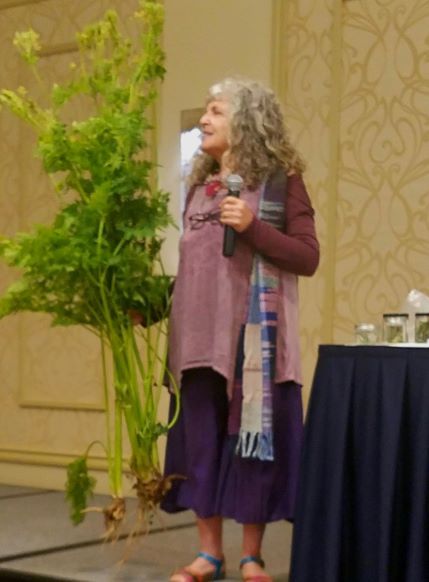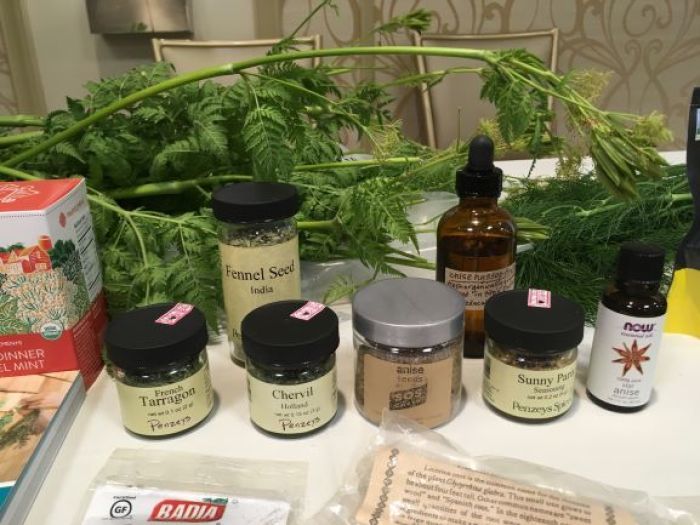
I recently did a program at the annual Herb Society of America conference in Madison, Wisconsin thus titled; this is a modified version of the handout. Since we are celebrating Agastache as Herb of the Year for 2019 and Anise Hyssop is the most popular of this genus, I figured I’d explore some of the other herbs in this flavor category. Anise hyssop is not related to anise (Pimpinella anisum), or hyssop (Hyssopus officinalis) for that matter. It does however, smell and taste somewhat like anise. When we speak of anise flavor, a few other herbs come into play: fennel and licorice. These three herbs have similar aromas and tastes due to a few shared chemical constituents. And these three herbs are used to describe the flavor profiles of some other well-known herbs. Although there are probably a few other herbs that have some flavor of anise, fennel or licorice, I will discuss the ones listed below that I am most familiar with.
Basic Chemistry
Some chemicals are common to a variety of plant foods, which results in comparable flavors between these foods. The two main chemical constituents that give these similar flavored herbs their smell and taste are estragole and anethole. According to Tucker and DeBaggio in the Encyclopedia of Herbs, “Anethole is very similar in structure to estragole (methyl chavicol) in tarragon and safrole in sassafras, and so these oils smell similar but not identical.” Anethole is a terpenoid, and is found in anise and fennel, and also dill, which it is named after (Anethum graveolens) even though it is a much smaller amount found in dill than anise and fennel. Estragole is a phenylpropene, which is a natural organic compound, also called methyl chavicol.
Anise (Pimpinella anisum) Parts used: leaves and flowers; mainly seeds
Chemistry: primarily (E)-anethole; germacrene D, beta-bisabolene and estragole.
Anise hyssop (Agastache foeniculum) Parts used: leaves and flowers
Chemistry: primarily estragole; germacrene D, limonene, (E)-ocimene; some forms contain isomethone and pulegone.
Basil (Ocimum spp.) Parts used: leaves, flowers, seeds
Chemistry: primarily estragole and linalool, some forms contain eugenol, 1,8- cineole, beta-caryophyllene.
Chervil (Anthriscus cerefolium) Parts used: leaves and flowers
Chemistry: primarily estragole, some 1-allyl-2, 4 dimenthoxybenzene.
Dill (Anethum graveolens) Parts used: leaves, flowers, seeds
Chemistry: carvone, limonene, dill apiole, alpha-phellandrene.
Fennel (Foeniculum vulgare) Parts used: leaves, flowers, seeds
Chemistry: (E)-anethole, estragole, fenchone, limonene
French Tarragon (Artemisia dracunculus ‘Sativa’) Parts used: leaves
Chemistry: primarily estragole; some contain (Z)-anethole, beta-ocimene.
Licorice (Glycyrrhiza glabra) Parts used: root
Chemistry: glycerrhizin, hexanoic acid, hexadecenoic acid, acetol, propionic acid, as well as various alkylpyrazines, flavonoid glycosides, sugars and starch.
Mexican tarragon (Tagetes lucida) Parts used: leaves and flowers
Chemistry: primarily estragole; (E)-anethole, methyl eugenol.
Sweet cicely (Myrrhis odorata) Parts used: roots, leaves, flowers, seeds
Chemistry: primarily (E)-anethole in both fruits and foliage
In the Kitchen
Although anise and fennel seeds have slightly different flavor characteristics-they can be substituted for one another in most recipes-I find aniseed more assertive in flavor and fennel seed milder and a bit sweeter. They are wonderful in baked goods from breads and muffins to cakes and cookies. They are used in pickles, salads, soups, sauces, stews, with meats, especially sausages, fish, poultry, vegetables, grains and cheeses. Though they are used in many cuisines, I find them often featured in Indian and Italian foods and spice blends like Indian panch phoron, curry powder, Chinese five spice and herbes de Provence. There are many liqueurs and cordials made with anise and fennel seeds.
Foliage of these aromatic plants are used in recipes around the globe and will brighten a salad, soup, sauce, any egg dish and are tasty with pasta, grains, vegetables, fish and fowl. Flowers have a surprising amount of flavor due to concentrated essential oils-use them as a garnish on salads or beverages-or put a flower umbel in your pickle jar. I use leaves and blooms in making herb butters, vinegars and syrups. The famous French blend of fines herbes contains the quartet of tarragon, chervil, parsley and chives, however if tarragon doesn’t do well for you or the chervil has gone to seed, why not substitute anise hyssop, sweet cicely or fennel fronds?
Celebrate Agastache as Herb of the Year 2019 along with these anise-, fennel-, and licorice flavored herbs–grow these flavorful plants in your garden–and get creative in the kitchen! A more in-depth article appears in Agastache, Herb of the Year 2019: Anise Hyssop, Hummingbird Mints and More! published by the International Herb Association.




















Comments
Log in or create an account to post a comment.
Sign up Log in